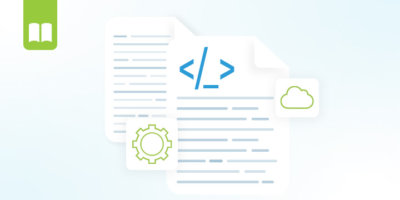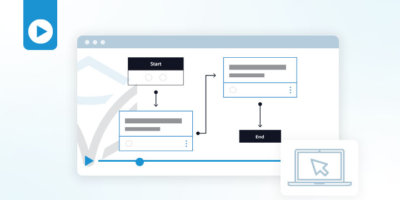One may think that everything you need to know about the network exists solely on devices (both physical and virtual) and on controllers in the form of configuration data and operational state. However, to fully understand the network, teams must also reference multiple sources of truth to make the most basic of changes to the network. Once a change is made there’s also the time and effort it takes to turn around and update each distributed source of truth. Network and IT teams end up spending most of their time updating copies of data in several places every time a change is made, and that is just not sustainable. Since this process is manual, data ends up being replicated in multiple sources and it’s often not accurate. This leave teams feeling they don’t know their own network.
With the huge volume of change requests coming at practitioners and the manual processes currently being leveraged to execute them, it’s no wonder why teams are constantly in a state of playing “catch up,” simply trying to just keep things from breaking. The entire world of networking has been built around humans working on a single device at a time, or maybe a script in some cases, but by adopting this operating model, there’s just not enough time in the day to what needs to be done – deploy, manage, and operate the network.
Now that network devices and services are distributed across more and more domains including data center, public cloud, private cloud, physical infrastructure and more, the current tools and processes in place for managing network configuration and network change requests no longer work in this new world of rapid change across multi-domain and multi-vendor networks.
Why Current Approaches to Managing Network Operations Aren’t Working
The hard truth here is that there isn’t just one reason, but many as to why the current way isn’t working for your organization.
You can’t keep up with the pace of change on the network.
Teams are tasked with more and more network changes every day, but current processes are creating a never-ending backlog of work. Over 40% of enterprises are asked to make major changes to the network daily, meaning device software and security updates are coming daily, this rate of change is impossible to maintain manually.
Existing process for managing network change requests is manual, slow, and limited.
Teams are trying to move faster and automate more but need to maintain the integrity of the network and are constantly worried that their current tools and processes aren’t up for the task. This puts an unwanted perception in your organization that the network teams move too slowly.
90% of the work and time required to make a network change is spent on the coordination of management activities (pre- and post-checks, documentation, user notification, IPAM/CMDB updates, etc.) and only 10% of the process time is actually spent on device configuration. Not to mention, 75% of enterprises are concerned that the current tools and processes they have for making network changes are introducing errors. This makes it nearly impossible to understand the state of configuration of their networks.
There is a skills gap on your team inhibiting automation.
At least 60% of organizations are automating some tasks on their network with one-off scripts or unsupported open source tools, but this means that most of the time there are one or two team members that know how to code automations and remaining members rely on manual changes to individual devices. It doesn’t help that most automation solutions require users to learn how to code, making it nearly impossible for collaborative automation.
Redefining Network Automation for the New Era
The only way for network management to become successful and efficient is by redefining what network automation means in this new era that spans across domains, vendors and requires constant change management. Here’s how:
Keeping up with the pace of change by automating end-to-end.
Expand your automation efforts past the network change itself and develop automations that encompass the entire processes of each change such as pre- and post-checks, updating sources of truths, notifications, etc. This will free up a significant amount of time for your team to focus on larger initiatives.
Adopt new process and tools that scale to meet current and future network needs.
With more ways to access devices than ever before (APIs, CLI, scripts), teams need to find a way to leverage them. Modern solutions offer a way to integrate and interact with all your devices, tools, and services through a single control pane, regardless of where they live or how they are accessed. This means you can integrate and coordinate all network change management activities, regardless of vendor. This allows teams to apply more rigor and controls than ever before, eliminated the need to replicate data in multiple places or needing to copy data across systems to make a change.
With this new approach, teams can now leverage network devices (both physical or virtual) as the source of truth, as opposed to a topology map or CMDB, by communicating directly with each device in real-time.
Embrace democratization through low-code.
Teams can onboard a low-code automation tool that allows network engineers to automate changes on the network without having to learn or understand software development, removing any skillset barriers to automation.
How Itential is Helping Teams Break the Network Automation Status Quo
Itential is a network automation company focused on solving two fundamental challenges that enterprises are facing today; improving the visibility and management of the configuration of the network and increasing the velocity of change and utilization of the network. The Itential Automation Platform was built help enterprises evolve automation efforts past the status quo of today by:
Keeping up with the rate of change on your network.
Our customers are able to make more changes with less errors than they were ever able to do before using manual processes.
Automating the full process, not just tasks.
Our vendor-agnostic solution integrates with every system in your ecosystem such as DevOps platforms, ITSM, IPAM, CMDB, etc., allowing teams to automate and orchestrate the most time-consuming tasks involved in a network change requests outside of the change itself. We built a library of out-of-the-box network-facing tasks, a workflow engine that ties together these tasks, coupled with the ability to auto-generate integrations with any third-party system (whether it be off the shelf or custom) to provide a comprehensive network automation solution. This also provides the ability to auto-discover configuration and operational data directly from the devices, making the source of truth for network changes the device itself
Eliminating the skill gaps on teams.
Our low-code environment was built with network engineers in mind, so that they can drag-and-drop these network-facing tasks, API calls and integrations onto a visual canvas for end-to-end network automation changes. By consuming all your existing automations (scripts, Ansible, Terraform, etc.), our platform helps build configuration guardrails around them and publish them for your entire team to use, further enabling collaborative automation.
To learn more how Itential helps network teams along their automation journey, check out this demo video to each of these features in action or schedule a custom demo with our automation expert.





